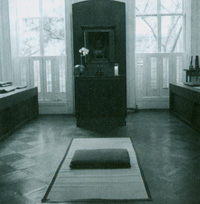
After he sits zazen on Tuesday evenings, Gordon MacKenzie of Kettering, Ohio, gets up from his zafu cushion, dials California, and dons a headset connected to his phone. He then returns to his cushion, resumes a cross-legged position, and speaks with his teacher in a ritual that has become modern America’s variation on an ancient Zen tradition: dokuphone.
That is the name some practitioners give to long-distance forms of dokusan, the teacher-student interview session. MacKenzie spends fifteen to thirty minutes speaking with Sensei Daniel Terragno (a teacher at Rocks and Clouds Zendo in Sebastopol, California) in much the same way Zen teachers and students have for centuries. The only difference is that MacKenzie cannot see his teacher, and the bows, bells, and other accoutrements of a formal dokusan session are absent. “I’ve told him I need a cardboard cutout of him to put in front of me,” he joked.
For practitioners like MacKenzie, who belong to sanghas without resident teachers, receiving guidance isn’t as simple as consulting a teacher in the next room during a sitting period. In addition to dokuphone, it sometimes involves making long trips to Zen centers, or meeting with teachers during retreats. These options are not ideal for practitioners who crave the immediate teacher-student contact that brought awakening to ancient Zen masters and still brings confidence, clarity, challenge, and encouragement to Zen students today. But these practitioners have adapted to counter a modern-day situation that is the consequence of a transient society and an insufficient number of dharma teachers to serve it.
Although many options for teacher-led practice exist on the West and East coasts, where American Buddhism has flourished, many practitioners in Middle America must make do with a teacherless practice.
Every Sunday at the Buddhist Dharma Center of Cincinnati, the wisdom of a great Zen master is channeled through the voice of an ordinary practitioner reading a classic Zen text. The center is unaffiliated with a teacher and proud of it. It lays no claim, either, to a particular Zen tradition, simply offering basic Zen “services” such as weekly sittings, a lending library, and a beginners’ instruction night.
Its founders—Michael Atkinson, a professor of English at the University of Cincinnati, and Bonnie Beverage, a high school teacher—have received authorization to teach in the Zen and Theravada traditions, respectively, but they resist promoting themselves as teachers. On Tuesdays, Atkinson, Beverage, and a few other members give dharma talks. “But our best discussions are in the hallway,” Beverage insists, indicating that members of the Cincinnati sangha have, in some ways, become one another’s teachers. At the back of the sangha’s hall is a small room that has all the trappings of a dokusan room: two mats and cushions laid out on the floor. But instead, the room is for private discussions between sangha members about dharma issues or problems that exist between them.
“A teacherless sangha just works for my personality,” remarked Laura Schaber, who admits to being an independent spirit. “While I respect tradition, I work well without it. If I want to participate very little, I can.” Some sangha members maintain that books provide them with sufficient guidance; the proliferation of Buddhist books over the past decade may in part be the result—or the cause—of the increasing number of teacherless sanghas around the country.
Many teachers, however, contend that sitting without a teacher present denies practitioners the opportunity to deepen their practice. “Most of the time we’re stumbling in the dark, and if our life is to be truly transformed, we need someone to point that out to us,” said Reverend Kyoki Roberts, founder of the Zen Center of Pittsburgh.
Stephan Bodian, a San Francisco–area psychotherapist and Zen teacher, finds it no surprise that Americans, who live in such an informal culture, might be uncomfortable with practice forms imposed by a teacher. Still, he insists, “A teacher transmits the truth through his or her movements and gestures and ways of being.”
A year ago, the members of the Yellow Springs Dharma Center, in Yellow Springs, Ohio, decided they wanted to do more to deepen their practice than just hold sittings in the small house that accommodates their sangha. So the group asked Sensei Daniel Terragno to be their guiding teacher. Terragno had made a deep impression on the Yellow Springs students during the few retreats he’d led with them as a visiting teacher. But after he became guiding teacher, the sangha made it a point not to pressure anyone to be Terragno’s student. “We wanted to make it really clear that we weren’t telling people who their teacher had to be, but that we were simply making one available to them,” says Donna Demna, the group’s de facto leader.

Terragno now speaks regularly at the Yellow Springs sangha and advises the group on books they can read for their joint discussions with a sangha in Columbus that also works with Terragno. “It’s important to have a certain edge in your spiritual practice,” he said. “When you’re committed to working with a teacher, you permit yourself to be kicked in the butt once in a while.”
Gordon MacKenzie practiced Zen for seven years before committing to Terragno. After he did, he realized he was making a commitment not just to a teacher but also to the Zen path. “Teachers can’t take you on the journey, but they can constantly look over your shoulder,” MacKenzie said.
Ruth Fullmer, however, has decided not to take on Terragno as her teacher at Yellow Springs but to rely on books, fellow sangha members, and loved ones to show her the way. “Right now, my eighteen-month-old grandson is my biggest teacher.”
Practicing with a teacherless sangha doesn’t just have implications for one’s spiritual state. It also affects the day-to-day administration of the sangha: recruiting new practitioners, cultivating leadership, instructing beginners, and deciding which practice forms to adopt. Lay members must hammer out these issues among themselves, taking care not to alienate anyone if changes must be made. “It means having a common goal, common values, and those can’t be assumed,” said Sensei Wendy Egyoku Nakao, abbot of Zen Center of Los Angeles. “’How do we practice together?’ That’s always the question, whether you have a teacher or not.”
In South Bend, Indiana, Tom Brown spent fourteen years overseeing the South Bend Zen Group, which he founded, and which met at a local church. But last spring he suspended the group, in part because the core of people who’d been keeping the sangha strong moved away, and Brown didn’t have time to recruit new members. Brown doesn’t believe time constraints are what caused people to shy away from leadership roles but feels rather that they equated those roles with a greater commitment to Zen.
To help laypeople with the challenges of running a sangha, San Francisco Zen Center recently appointed priest Michael Wenger to the new position of liaison between the center and its growing number of affiliated sanghas, some of which do not have teachers. “It’s true there are some groups that want to figure it all out for themselves, but they usually don’t last very long,” Wenger said.
Zen Mountain Monastery, in Mount Tremper, New York, has begun responding to teacherless practitioners by running a website feature called “Cybermonk” (www.mro.org). Practitioners send an e-mail question to the Cybermonk and get an email response from a senior monastic. The five-to-ten e-mails a day that come in from around the world are mostly from people without teachers, according to senior monastic Konrad Ryushin Marchaj. Cybermonk will not respond to questions about koans, psychological issues, “or to someone who says, ‘I’ve got my senior thesis on Mahayana Buddhism due tomorrow and I need help.’” Instead, those people will be referred to other resources, including teachers who do koan work by phone.
Marchaj said Roshi John Daido Loori, abbot of the monastery, does not believe in the use of e-mail or the phone to engage in koan work. Although he is considering experimenting with live visual contact via computers, Daido Roshi still believes that nothing substitutes for a face-to-face connection. “He says he needs to smell the sweat of the student.”
As Zen continues to unfold in America, sanghas without resident teachers will continue to spring up, and each one will, like the Buddhist Dharma Center of Cincinnati and the Yellow Springs Dharma Center, make unique choices that depend as much on sangha dynamics as on the practice needs of members. Perhaps in the near future, more teacherless sanghas will share information about their experiences, to help each other avoid pitfalls. Perhaps more newly ordained teachers will move to areas underserved by Zen teachers, or experiment with new ways to provide guidance from afar.
For now, it appears that practitioners without a teacher are engaging in the very American endeavor of making up their own minds on how to further their practice and how they should maintain the sanghas that give them strength. As John Atkinson of Norman, Oklahoma—who used to practice with Tom Brown in South Bend but found no local sangha when he moved to Norman—quips, “You could call us Zen cowboys.”